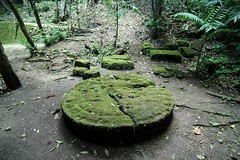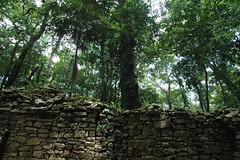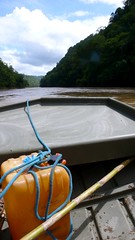
Had hoped to write something compelling and endlessly fascinating about Piedras Negras, because the Mayan site on the Usamacinta River was, after all, the whole reason I soaked myself in deet and took cloroquin only to be bitten ANYWAY by disease bearing mosquitoes (although bearing something else probably, because the malaria smear turned up negative. west nile’s the head runner, followed by dengue fever. still waiting for results on those.)
But because my brain is taking odd holidays at random moments I’ll stick to the basics and simply upload a handful of shots and prattle on a bit.

Piedras Negras doesn’t see a lot of visitors -- it’s not like the well-groomed sites of Tikal and Palenque or even the mildly groomed jungle site of Yaxchilan (pics from there to follow soon) -- Piedras Negras today is only a few narrow trails cut into a series of steep slopes.

Very few of the ruins are revealed to what little light makes it through the thick rainforest canopy: much has never been excavated and the little that has has been overtaken again by the jungle in the time it lay fallow between excavations and when it was home to guerillas and drug runners.
The real treasures (and they’re astonishing, the estella and thrones and other bas-relief of Piedras) have been spirited away to the National Gallery in Guatemala City (Piedras lies on the Guatemalan side of the river). What’s left on the site has mostly been overtaken by moss.

Piedras Negras matters because Tatiana Proskouriakoff did some of her most important work here -- as an artist developing reconstructive drawings of what the site looked like in its prime she puzzled out the obvious: that the estella -- stone monuments erected in front of the temples and structures of the site -- recorded histories. Not mythologies, as previously believed. Actual chronicles of the kings.
Her insight led to the subsequent rapid tumble decipherment of Mayan hieroglyphics. Well, maybe not that rapid, but something of a tumble, and still underway today.

The approach to Piedras Negras isn’t easy. For us it was an hour and half in the bed of a pick up truck, a slick descent down a muddy bank (well traveled by pollo -- the Usumacinta is a main thoroughfare on the underground highway into the U.S.) into metal skiffs that would ferry us for the next 45 minutes along the river, and then a sandy ascent up another steep bank to the site.

All of which contributed to the wholly giddy feeling that I had on the approach, and the scramble through the bush, through the green soaked sunlight and the thick under story and the muddled mossy edifices. Yeah. Could hardly see a thing. And it was heaven.
Even the indignity of squatting in the woods (there are no port-a-potties at Piedras) couldn’t shake off the feeling that comes from finally touching down at a place where so much history happened.

Tatiana’s ashes are interred on the acropolis -- a steep ascent up yet another mound that’s part hillside part structure part city beneath your feet. She’s surrounded by the whirring sounds of the jungle -- howler monkeys and tiny cicadas that sound like weed whackers and add a surreal edge that makes being in the middle of nowhere sound a little like being in the middle of the suburbs.







1 comment:
great narrative and pictures.."green soaked sunlight"
Post a Comment